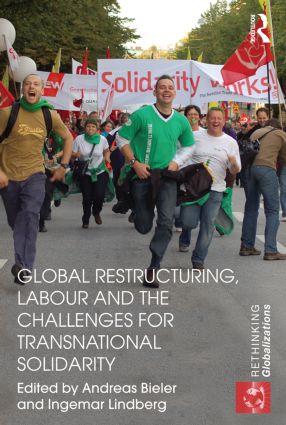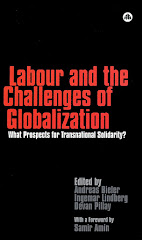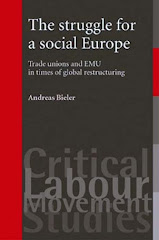In 2007 the Finnish employers’ confederation withdrew from
the comprehensive tripartite, multi-sector bargaining system, a step which had
been taken by the Swedish employers’ federation 17 years earlier. In Sweden, it
signalled to some extent the demise of the so-called Swedish model. In Finland,
by contrast, Finnish employers organised in EK and here especially
the Federation
of Finnish Technology Industries, which represents
Finnish export companies, did not succeed in enforcing company level bargaining
and, thus, more flexibility in wage structures. Instead, a sectoral collective
bargaining system, giving sectoral trade unions significant power, was
established. How can we understand this failure in comparison to the more
successful attack of the Swedish employers in the 1990s? In this blog post, I will argue
that the far lower degree of transnationalization of production in Finland
explains to some extent why the attack on the established class compromise
happened much later than in Sweden and has been less successful. Nevertheless, I will also conclude that trade unions must remain vigilant in their protection of the welfare state as further attacks are likely.
 |
| Photo by Christopher Neugebauer |
The step to withdraw
from the class compromise by Swedish employers in 1990 came against the
background of their sustained opposition to the Swedish model since the mid-1970s.
When the Social Democrats together with trade unions pushed for wage-earner
funds, which would have given trade unions control over investment in large
Swedish corporations, employers had started a strong pro-market campaign. This
was supported throughout the 1980s with a considerable shift of production
abroad to counter the Swedish government’s hesitation over EU membership. In
order not to be excluded from the Internal Market, companies decided to move
their production to locations inside the EU. However, it would be wrong to
argue that it was only the employers, which had contributed to the demise of
the Swedish model. Social Democratic governments throughout the 1980s had
started to implement neo-liberal restructuring. Most importantly, this involved
the deregulation and liberalisation of financial markets, depriving the state
of crucial tools of economic sovereignty. Swedish trade unions too had played a
role. In 1983, the Swedish Metalworkers’ Federation undermined labour
solidarity by agreeing on a separate wage deal with the employers of their
sector. Divisions over EU and EMU membership in the 1990s further weakened
labour unity. Can we identify similar developments in Finland?
 |
| Photo by the_girl |
Comparing the Finnish
and Swedish production structures, it is noticeable that the former is much
less transnationalised. While inward FDI stocks as a percentage of gross
domestic product were 76 per cent in Sweden in 2010, they were only 34.6 per
cent in Finland. The figures for outward FDI stocks as a percentage of gross
domestic product are 73.2 per cent and 54.7 per cent respectively (Bergholm
and Bieler 2013: 7). In contrast to Sweden, Finnish production with the
exception of Nokia is not characterised by the dominance of large transnational
corporations. The way Finland is most closely integrated with the global
economy is through the country’s focus and dependence on exports – Finnish
exports account for 40 per cent of Finland’s GNP – and this requires to some
extent also the co-operation by trade unions in the organisation of the
national political economy. Export-oriented Finnish capital’s structural power
has not yet been enough to pressure trade unions into accepting further
decentralisation of collective bargaining.
 |
| Photo by Zache |
Nevertheless, Finnish trade unions must not be complacent in
their defence of the welfare state and working class achievements. When in
opposition between 2007 and 2011, the Finnish Social Democrats adopted a
leftist discourse, portraying themselves as the defenders of the Finnish
welfare state. This should not make one overlook, however, that they had
accepted neo-liberal economic principles in the 1990s and had been part of a
large coalition government from 1995 onwards, which is credited with some of
the most severe restructuring in the Finnish political economy. Back in power
since 2011, again as part of a broad coalition, there is at least the danger
that neo-liberal restructuring will continue in an incremental fashion as a
result of consensus policy-making.
Trade unions too should not be too confident as a result of
having been able to hold the employers to collective bargaining at the sectoral
level. This very step has brought to the fore some tensions within the Finnish
labour movement. While the Metalworkers’ Union, concerned about the
competitiveness of the Finnish export industry, would have preferred to stick
with multi-sector bargaining across the whole economy, public sector unions and
private domestic service sector unions welcomed the decentralisation of
collective bargaining to the sectoral level, as this would allow them to close
the gender wage gap between their predominantly female members and male workers
in export manufacturing (see also Finnish
trade unions in changing times – Part I). Similar tensions can
be identified over employer pressures towards privatisation of the public
sector. While public sector unions and blue-collar trade unions more generally
oppose this attack on the public sector, white collar-unions especially in the
export sector are much less concerned.
 |
| Photo by hugovk |
In October 2011, the Swedish employers’
confederation EK and the trade unions, with the strong support of the
government, reached a national, multi-sector framework agreement on pay and
conditions and several social reforms in areas including unemployment insurance
and parental leave. Considering, however, continuing disagreements between employers
and trade unions over how to implement key aspects of this agreement, the
indications are that this reversal of developments will only be temporary. A
re-emergence of full neo-liberal restructuring pressures is highly likely. Finnish
trade unions must remain vigilant in their protection of the welfare state (see
also Finnish
trade unions in changing times – Part II). Trade
union unity remains essential in Finland in order to resist neoliberal
restructuring.
This blog post is based
on the article
Prof. Andreas Bieler
Professor of Political Economy
University of Nottingham/UK
15 February 2013
















No comments:
Post a Comment
Comments welcome!